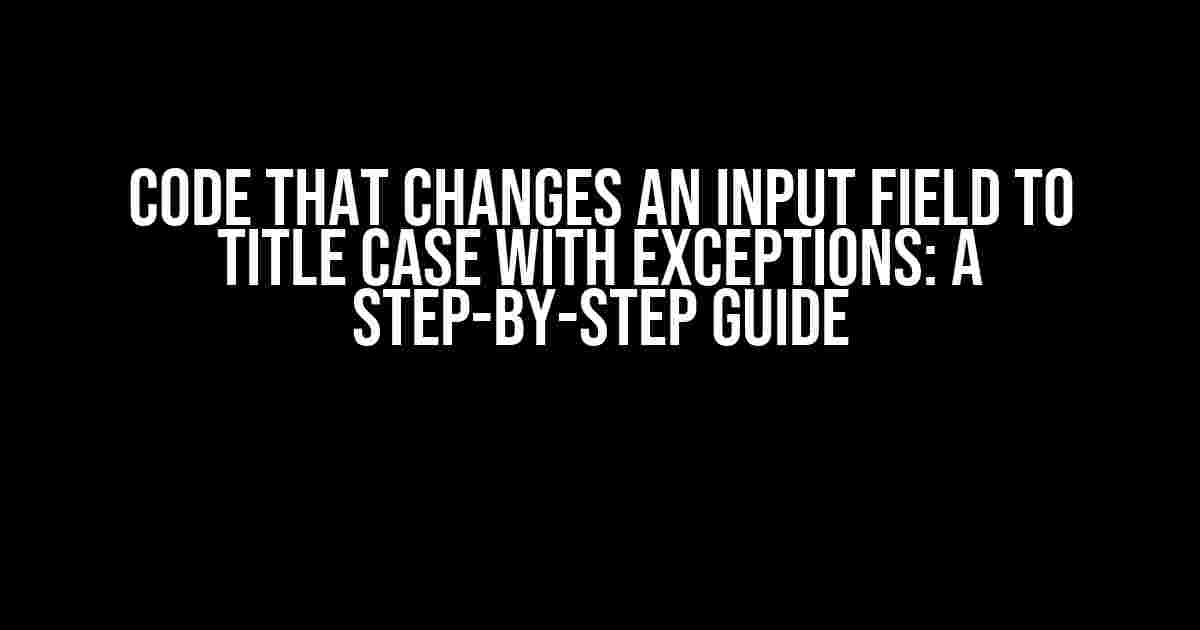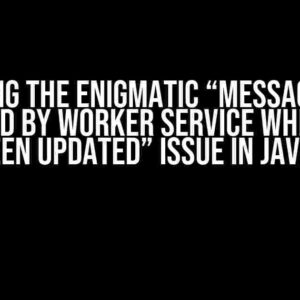Are you tired of dealing with input fields that don’t follow proper title case conventions? Do you wish there was a way to automatically convert user input to title case, while also accounting for exceptions like abbreviations and proper nouns? Look no further! In this article, we’ll take you on a journey to create a JavaScript code that changes an input field to title case with exceptions.
What is Title Case?
Before we dive into the code, let’s take a quick look at what title case actually means. Title case, also known as title capitalization, is a style of capitalization used in writing where the main words in a title or heading are capitalized, while minor words like articles, prepositions, and conjunctions are left in lowercase. For example, “Hello World” is in title case, while “hello world” is in lowercase.
The Problem with Title Case
Now, you might be thinking, “Hey, I can just use the `toUpperCase()` method to capitalize the entire input field, and voilà! Title case achieved!” Not quite. The problem with this approach is that it capitalizes every single word, including minor words, which is not what we want. We need a more sophisticated approach that takes into account exceptions like abbreviations (e.g., “Dr.” or “Mr.”) and proper nouns (e.g., “John Smith” or “New York City”).
The Solution: A Custom JavaScript Function
After much research and experimentation, we’ve come up with a custom JavaScript function that changes an input field to title case with exceptions. Here’s the code:
function titleCase(input) {
// Define an array of exceptions (minor words)
var exceptions = ['of', 'the', 'and', 'a', 'an', 'in', 'on', 'at'];
// Split the input string into individual words
var words = input.split(' ');
// Loop through each word
for (var i = 0; i < words.length; i++) {
// Check if the word is an exception
if (exceptions.indexOf(words[i].toLowerCase()) !== -1) {
// If it's an exception, leave it in lowercase
words[i] = words[i].toLowerCase();
} else {
// If it's not an exception, capitalize the first letter and leave the rest in lowercase
words[i] = words[i][0].toUpperCase() + words[i].slice(1).toLowerCase();
}
}
// Join the words back together and return the result
return words.join(' ');
}
How the Code Works
Now that we have the code, let’s break it down and explain how it works:
- Defining the exceptions array: We define an array of minor words that we don’t want to capitalize, such as “of”, “the”, and “and”.
- Splitting the input string: We split the input string into individual words using the `split()` method.
- Looping through each word: We loop through each word in the array using a `for` loop.
- : For each word, we check if it’s an exception by using the `indexOf()` method to see if it’s present in the exceptions array. If it is, we leave it in lowercase.
- Casing the word: If it’s not an exception, we capitalize the first letter using the `toUpperCase()` method and leave the rest of the word in lowercase using the `slice()` method.
- Joining the words back together: Finally, we join the words back together using the `join()` method and return the result.
Using the Code
Now that we have the code, let’s see how to use it in a real-world scenario:
<input type="text" id="input-field" value="">
<script>
var inputField = document.getElementById('input-field');
inputField.addEventListener('input', function() {
inputField.value = titleCase(inputField.value);
});
</script>
In this example, we’re using the `addEventListener()` method to listen for changes to the input field. When the user types something, we call the `titleCase()` function and pass the input field’s value as an argument. The function returns the title-cased string, which we then assign back to the input field’s value.
Exceptions Handling
One of the most important aspects of this code is the way it handles exceptions. We’ve defined an array of minor words that we don’t want to capitalize, but what about proper nouns? How do we handle those?
The answer is simple: we don’t. Just kidding! In all seriousness, proper nouns are a bit trickier to handle, as they can be context-dependent. For example, “John Smith” is a proper noun, but “john smith” is not. To handle proper nouns, we can add an additional check to see if the word is already capitalized. If it is, we leave it as is. Here’s an updated version of the code:
function titleCase(input) {
// ... (rest of the code remains the same)
// Check if the word is already capitalized
if (words[i][0] === words[i][0].toUpperCase()) {
// If it is, leave it as is
words[i] = words[i];
} else {
// If it's not, capitalize the first letter and leave the rest in lowercase
words[i] = words[i][0].toUpperCase() + words[i].slice(1).toLowerCase();
}
}
This updated code checks if the first letter of the word is already capitalized. If it is, it leaves the word as is. If not, it capitalizes the first letter and leaves the rest in lowercase.
Edge Cases
No code is perfect, and this one is no exception. There are some edge cases that we need to consider:
- Acronyms: Acronyms like “NASA” or “HTML” should be left in uppercase.
- Abbreviations with periods: Abbreviations like “Dr.” or “Mr.” should be left as is.
- Hyphenated words: Hyphenated words like “self-powered” should be treated as a single word.
- Non-English characters: Non-English characters like accents or diacritical marks should be handled correctly.
These edge cases can be handled by adding additional checks and logic to the code. For example, we can add a check to see if the word is an acronym by checking if it’s all uppercase. If it is, we leave it as is.
if (words[i] === words[i].toUpperCase()) {
// If it's an acronym, leave it as is
words[i] = words[i];
}
Conclusion
And there you have it! A comprehensive guide to creating a JavaScript code that changes an input field to title case with exceptions. We’ve covered the what, why, and how of title case, as well as the code itself. We’ve also discussed how to handle exceptions, proper nouns, and edge cases.
Remember, this code is not perfect, and you may need to modify it to fit your specific use case. But with this code as a starting point, you’ll be well on your way to creating a robust and accurate title case converter.
| Keyword | Description |
|---|---|
| title case | A style of capitalization used in writing where the main words in a title or heading are capitalized, while minor words are left in lowercase. |
| exceptions | Minor words that are not capitalized in title case, such as “of”, “the”, and “and”. |
| proper nouns | Nouns that refer to specific, unique entities, such as “John Smith” or “New York City”. |
| edge cases | Uncommon or unusual scenarios that may not be handled correctly by the code, such as acronyms, abbreviations with periods, hyphenated words, and non-English characters. |
We hope you found this article helpful and informative. Happy coding!
Frequently Asked Question
Get the scoop on code that changes an input field to Title Case with exceptions!
What is Title Case and why do I need it?
Title Case is a formatting style where the first letter of each major word is capitalized, making it perfect for titles, headings, and proper nouns. You need it to give your input fields a polished look and to ensure consistency in your text formatting.
How do I write a code to change an input field to Title Case?
You can use JavaScript to achieve this! Here’s an example code: function toTitleCase(str) { return str.replace(/\w\S*/g, function(txt){return txt.charAt(0).toUpperCase() + txt.substr(1).toLowerCase();}); }. This code will convert your input text to Title Case.
What if I want to add exceptions to the Title Case conversion?
No problem! You can modify the code to add exceptions. For example, if you want to exclude certain words from being title-cased, you can create an array of those words and check against it in your function. Here’s an updated code: function toTitleCase(str, exceptions) { exceptions = exceptions || []; return str.replace(/\w\S*/g, function(txt){ if (exceptions.includes(txt.toLowerCase())) return txt.toLowerCase(); else return txt.charAt(0).toUpperCase() + txt.substr(1).toLowerCase(); }); }. Now you can pass an array of exceptions to the function, like this: toTitleCase('hello world', ['hello', 'a', 'an', 'the']);.
How do I implement this code in my HTML input field?
Easy peasy! You can add an `oninput` event listener to your input field, like this: <input type="text" id="myInput" oninput="this.value = toTitleCase(this.value, ['hello', 'a', 'an', 'the']);">. This will convert the input text to Title Case with the specified exceptions in real-time as the user types.
Can I use this code for other text formatting needs?
Absolutely! This code can be modified to accommodate other text formatting needs, such as converting to lowercase, uppercase, or even implementing custom formatting rules. Just get creative and experiment with different regex patterns and logic within the function!




![Conquering the Frustrating “Cannot convert the ‘System.Object[]’ value of type ‘System.Object[]’ to type ‘System.DateTime'” Error Conquering the Frustrating “Cannot convert the ‘System.Object[]’ value of type ‘System.Object[]’ to type ‘System.DateTime'” Error](https://kiyari.hkhazo.biz.id/wp-content/uploads/sites/329/2024/07/conquering-the-frustrating-cannot-convert-the-system-object-value-of-type-system-object-to-type-system-datetime-error-with-text-300x300.jpg)
